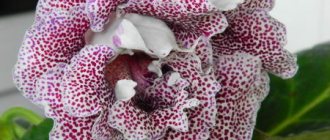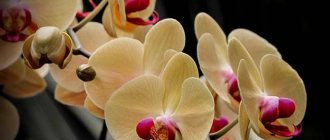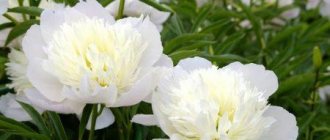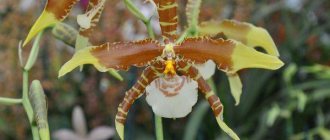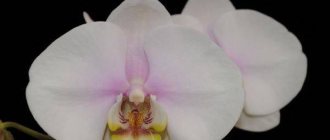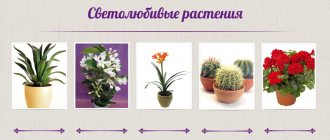The secret of the name
The genus Phalaenopsis belongs to the epiphytic plants of the Orchidaceae family. The plant is native to the plains and forests of Southeast Asia, the Philippines and northeastern Australia. The characteristic structure of plants belonging to this genus includes:
- Long vertical stem.
- Several large fleshy leaves arranged in two rows.
- Large velvety flowers, similar to exotic butterflies.
Thanks to these flowers, phalaenopsis got its name, since in translation from Greek phalania means “night butterfly” and opsis means “resemblance.”
In nature and special nurseries, there are about 70 species and a huge number of hybrid varieties of phalaenopsis orchids.
Exotic colors
These colors include blue and black phalaenopsis, which have been very popular in recent years:
- Blue coloration is extremely rare in phalaenopsis. Natural species of blue phalaenopsis have small whitish-blue or pink-blue flowers. They stubbornly pass this color on to their hybrids;
Phalaenopsis Vanda.
- Black Orchid. In nature, there are no plants with black flowers, which is due to their lack of such pigment. All Phalaenopsis hybrids that are tinged with black are actually a deep violet or purple color.
Phalaenopsis Black Butterfly.
How to determine the type of flower?
Under the generic name you can find plants that are completely different from each other: this name can be worn by either a thin tall stem with a pair of graceful flowers on top, or a lush garland studded with velvety “moths”. The following features will help you distinguish between types and varieties:
- Phalaenopsis are divided into two types according to height: ordinary, whose height is a meter, and miniature, whose dimensions do not exceed 30 cm.
- The color of flowers and even the color of leaves varies from species to species; hybrid varieties allow you to achieve incredible shades inherent in a particular species.
- The number of flowers on one peduncle.
- Some varieties emit pleasant, delicate aromas more intensely than others.
- The shape of a flower is one of the most revealing elements. Flowers have a different number of petals, and their location at the tip of the peduncle is also different.
Landing
Due to the fact that hybrid phalaenopsis are unpretentious to home conditions, if simple rules are followed, they grow well and bloom regularly.
Priming
Soil for orchids is sold at any flower shop, but you can prepare it yourself.
The most common substrate for orchids is pine bark , removed from dead wood or a cut tree. It is mixed with charcoal, perlite (foam granules) and a moisture-intensive component - sphagnum moss .
Before planting phalaenopsis, the substrate is slightly moistened.
Optimal capacity
An orchid is an epiphytic plant, so it needs a pot rather to support the plant and as a stand:
- The ideal container for pholenopsis is a translucent flowerpot made of plastic or glass . In it, the roots will not be able to grow into smooth walls, and the transparent material will provide them with enough light;
- the flowerpot must have drainage holes through which excess water will drain;
- The size of the container is selected according to the volume of the roots: they should fit tightly into the flowerpot.
A properly selected container will ensure healthy growth and rapid development of the orchid.
Peculiarities
The best time to transplant an orchid is spring; at this time, it usually does not bloom . When preparing a plant for transplantation, you must adhere to the following rules:
- Expanded clay is placed at the bottom of the flowerpot to a height of 1/4 of the volume to protect the roots from rotting;
- the plant is soaked in water to make it easier to remove from the flowerpot;
- clean the roots from the substrate;
- rotten roots are removed down to living tissue, the cut site is covered with crushed activated carbon;
- The roots are washed in water and allowed to dry for about 15 minutes.
When planting, the roots of the orchid are lowered into the pot, at the same time the prepared substrate is added and lightly shaken to evenly distribute the soil.
Phalaenopsis transplant.
Important! Try to leave the roots that grew above the surface of the pot open.
With proper transplantation, you can expect phalaenopsis to bloom within a year.
Flower colors
To determine the name of a varietal orchid of the genus Phalaenopsis by the appearance of a living flower or from a photo, it is worth focusing on the color of the flowers. Shades vary over a very wide range:
- Single color (white, red, yellow, purple, lilac, pink, lilac). Read about the mythical blue shade of phalaenopsis here.
- Multicolor (flowers with stripes, specks, veins, two-color petals).
A beautiful combination is the contrast between the shades of all the petals and the lip of the flower.
Reproduction methods
There are several ways to vegetatively propagate phalaenopsis at home:
- cuttings, for this purpose a faded peduncle is used;
- children that form on the phalaenopsis stem or peduncle after flowering.
This will allow you to grow an exact copy of your orchid yourself.
Propagation of phalaenopsis by cuttings.
Hybrid
Crossing phalaenopsis is not one of the most labor-intensive processes in botany, so industrial cultivation is reaching new heights in the cultivation of this genus of orchids. Hybrids are divided into several categories, depending on the size of the flower and the type of flowering.
Miniature (Phal. Mini Mark “Maria Teresa”)
- A striking representative is mini phalaenopsis. They are very convenient to keep at home or in the office; they do not take up much space.
- Fragile graceful flowers are painted in different shades, from light pink to rich tones.
Taiwanese (Amboinensis, Venosa, Violacea)
- Unlike miniature, discreet flowers, orchids of this group are strewn with large flowers of exotic colors.
A distinctive feature is the unusual colors, the sharp contrast between the petals and the lip. - The unpretentiousness of plants was also included by botanists in this section of hybrids.
Novelty Group
This group includes: Prefection In "Chen", l-Hsin Spot Eagle "Montclair", Nobby's Pacific Sunset "Red Pearl", Brother Pirate King "Sapphire Dragon", Misty Pride "CR".
- The uniqueness of the group is that after finishing flowering, the plant goes into a resting phase. Then the peduncle comes to life, and by the new flowering period new buds appear from its top.
- An orchid produces two or more flower stalks at once.
- Another distinctive feature of Novelty hybrids are specks, strokes, veins and other patterns on the petals.
In addition to the above varieties and hybrids, phalaenopsis also deserve the attention of the gardener: Big Lip, Wild Cat, Liodoro and Multiflora.
Natural views
Phalaenopsis are the most unpretentious and popular orchids for home breeding. They have monopodial growth, which is a distinctive feature. The stem of this genus of orchids does not branch and grows slowly in length. It can reach 40 cm during the flowering period and produces 1-2 leaves once a year. Flowers gradually bloom from the base to the crown and can maintain a decorative appearance for several months.
You can often find pleasant phalaenopsis (Phalaenopsis amabilis), Schiller's phalaenopsis (Phalaenopsis schilleriana) and Stewart's phalaenopsis (Phalaenopsis stuartiana). Stewart's phalaenopsis (Phalaenopsis stuartiana) and Schiller's phalaenopsis (Phalaenopsis schilleriana) are distinguished by snow-white flowers with scarlet patches and variegated leaves. Of particular interest are the forms of these species with large, colorful flowers.
Phalaenopsis amabilis (Phalaenopsis amabilis)
This orchid is also classified as Phalaenopsis charming. Found in Australia, Indonesia, and the Philippines. One of the key species used in hybrid breeding. A monopodial plant on a short stem is distinguished by lush flowering and unpretentiousness.
Phalaenopsis amabilis is popular in indoor and greenhouse floriculture. On the short stem of an adult plant, 4-5 two-row leaves grow, reaching up to 50 cm in length and 20 cm in width. The surface is glossy and shiny, sometimes with a pattern of yellow longitudinal stripes. The shape of the leaves is elongated-elliptical. A healthy plant has smooth branched roots and a strong rhizome.
Inflorescence with numerous flowers and a strongly branched large curved raceme (40-70 cm). The peduncle produces about 15-20 buds, which open into large white flowers up to 7-10 cm in size. Over time, the petals acquire a cream or light pink hue. Needs frequent watering, optimal temperature is +22…+27°C. Should be shaded from direct sunlight.
Phalaenopsis schilleriana
Phalaenopsis Schiller became the ancestor of many hybrid varieties. It is endemic to the Philippines, where it grows in warm tropical forests. During the flowering period, you should not allow a sharp change in daily temperature - this can cause the buds to fall off.
This species is similar in appearance to Phalaenopsis amabilis, but its main distinguishing feature is its variegated leaves. On the upper part they have spots of silver-gray and dark green, which are combined into stripes located transversely. Reddish spots can be seen below.
The inflorescence is multi-flowered (up to 200) and branched, reaching a length of 1.5 m. The size of each flower is 7 cm. The color is light pink, with lateral sepals with scarlet specks at the base. Flowering time is February-May. This species can be grown both in pots and epiphytically.
Phalaenopsis violacea
Phalaenopsis violation, or purple phalaenopsis, is found in Malaysia and on the island. Sumatra. It is distinguished by purple flowers, sometimes with a light green edging of the petals. But there are variations of white, lilac and pink shades, as well as specimens with speckled flower patterns.
The leaves are glossy, bright green, elliptical in shape, reaching 25 cm in length and up to 12 cm in width. The peduncles are zigzag, with a small number of buds that open one by one. The flower is waxy, up to 4-6 cm, fragrant. Phalaenopsis violet blooms profusely from June to October.
The optimal temperature should be within +18…+25°C. Do not allow direct sunlight to hit the flower. Violation loves high air humidity - 75-80% (at least 60%, otherwise the growth and development of the plant will slow down). When watering, ensure good drainage, otherwise the plant's roots will begin to rot.
In nature, it prefers to live on mangrove trees. In winter, water once every 2 weeks, in summer more often. Every 3rd watering it is worth applying fertilizers (root and foliar methods).
Phalaenopsis bellina
Phalaenopsis bellina is similar to Phalaenopsis violet. Habitat: o. Borneo. There is no clear opinion in the scientific community whether one of the species is one of the natural variations of the other. Bellina is distinguished by wider and oval petals and leaves, and larger flowers.
The stem is short with glossy bright green leaves, the shape is elongated and round, reaching up to 30 cm in length. Revolver-type peduncles produce up to 3 medium-sized flowers with a diameter of 5-7 cm with a strong aroma. The edging of the petals is pale green, the sepals are purple, pink, and lilac.
Tolerates sun well, preferably planted on a wood block. Requires moderately warm conditions (+18...+25°C) and air humidity of 50-70%. Watering no more than once every 10 days; due to the almost constant growing season, it requires regular feeding (once every 7 days).
Phalaenopsis stuartiana
This species was first seen on the island. Mindanao (southern Philippine archipelago). An evergreen orchid that produces up to 100 flowers during the flowering period with a subtle aroma. The flowers can reach up to 10 cm in diameter, but usually do not exceed 5 cm. Flowering periods occur in winter and spring.
The upper petals are wide, creamy-white, and at the base they are covered with a small scattering of colored spots. The lateral sepals are light yellow, the lip is covered with brownish-purple spots. The leaves are variegated, elliptical-oblong in shape. Healthy plants have pronounced turgor of green mass. It is worth watering no more than once a week.
Externally, this orchid resembles Schiller's phalaenopsis. Prefers partial shade, well-humidified air and a temperature of +22...+24°C. During the flowering period, fertilize every 2 weeks, during dormancy once a month. It is recommended to use lukewarm water for watering.
Phalaenopsis lobbii
The miniature orchid is found in India, Burma, and Vietnam, and grows on trees. First discovered by Thomas Lobb in 1845, today it is a protected species. In nature, it lives on the trunks and branches of old, moss-covered trees. Mature plants can produce several peduncles with a revolving type of flowering.
From the base of a short stem grow 2-4 pairs of elliptical leaves, up to 15 cm long and up to 5 cm wide. In winter, the plant sometimes actively sheds its leaves. The peduncles are thin and short (up to 10-15 cm), producing 2-6 buds almost all year round, opening sequentially. Flowers are up to 2 cm in diameter, dense, color from white to cream, the lip is wide, trilobed. There are 2 wide stripes of yellow color, the column is covered with brown specks.
The root system is well developed, with numerous branches. The preferred temperature range is +18...+30°C (taking into account daily differences). Phalaenopsis Lobba tolerates bright sun light and air humidity of about 70%. Standard watering regime (every 7-10 days). During the period of active flowering (February-May), it is worth feeding the orchid with special fertilizers every 2 waterings.
Phalaenopsis sanderiana
One of the rarest, most beautiful and expensive species of phalaenopsis. Named after the famous orchid lover Sander. The famous orchid researcher Lindley said about this plant: “a flower that is as charming as a beautiful young maiden.”
The stem is short, it has 2-6 dark green leaves with a variegated pattern, the leaf shape is oval, slightly pointed at the edges. The roots are smooth and well developed. On long, drooping peduncles, up to 50 flowers with a diameter of 5–8 cm are located in opposite rows. There are a variety of colors.
Large-flowered hybrid, peak flowering occurs in spring-summer. The preferred temperature is +23...+32°C and humid air (up to 80%). Abundant watering is required with a two-week break. Moderate lighting of medium intensity will be required.
Phalaenopsis tetraspis
Phalaenopsis Tetraspis, or four-shielded phalaenopsis, is found in India and Indonesia. During the flowering period (spring-summer) it produces a long peduncle (up to 30 cm). After the first flowers fade, the peduncle grows and new buds appear. Flowers up to 5 cm in diameter, usually white (sometimes with an admixture of red).
Adjacent to the trunk are up to 10 long, dark green leaves that curve toward the bottom. It feels great at 60-70% humidity in the room; if the air becomes drier, the orchid begins to turn yellow. Watering should be done intermittently so that the substrate has time to dry completely. For phalaenopsis tetraspis, watering using a warm shower is suitable.
A moderate temperature regime, range +20...+30°C (taking into account a daily difference of 10°C), is suitable for keeping. The plant loves bright light, but should be protected from direct sunlight. Fertilize once a month, during the active growing season every 2 weeks. Transplantation is recommended no more than once every 2-3 years, in March-April. After transplantation, you should not water the orchid for 7-10 days.
Phalaenopsis lueddemanniana
This species belongs to miniature orchids. The flower received its name in honor of the French breeder F. Luddeman. They grow in tropical Philippine forests with high humidity. They prefer temperatures of +23...+34°C; during the active growing season they should be fertilized once every 2 weeks.
The leaves are light green, oval in shape with pointed ends, grow up to 25 cm in length, up to 12 cm in width. The peduncle is straight or arched, has the same length as the leaves, or a little longer. Produces up to 5-7 buds, opening with flowers up to 5 cm in size.
The flowers are up to 7 cm in diameter, with variegated petals and sepals, as well as a small, three-lobed lip. Peak flowering is spring-early summer, the buds open alternately and emit a delicate aroma. The flowers are pink and purple, the shade is more saturated towards the center.
Doritis beautiful (Phalaenopsis pulcherrima)
The Phalaenopsis species Doritis pulcherrima does not have an established name in the Russian classification. These orchids are widespread and are found in China, India, Malaysia, Thailand, on the island. Borneo and Sumatra, in Cambodia, Vietnam and other countries. Gave rise to many hybrids called Doritaenopsis.
On a short stem there are 4-8 hard gray-green leaves of an elongated elliptical shape, slightly pointed at the ends. Sometimes on the leaves there is a pattern of fuzzy stripes or specks of a green tint. The root system is strong, well developed, the roots are highly branched, smooth, and silver in color.
During the flowering period, it produces a long peduncle (up to 60 cm) with multi-flowered inflorescences. Small flowers reach 1.5-4 cm in diameter, peak flowering occurs in October-December. Color ranges from pale and purple pink to deep lilac. The lip is three-lobed, the lateral lobes are straight, the middle lobe is elliptical, with the edges inward, the column is straight and narrow.
Doritis is a beautiful, unpretentious, heat- and moisture-loving plant to care for. This phalaenopsis prefers a temperature of +22...+24°C, air humidity 50-80%. Water at such a frequency that the substrate always remains slightly moist, but not wet. You should not fertilize during the dormant period (January-February); the rest of the time, fertilize every 10 days.
Phalaenopsis equestris
The miniature species Phalaenopsis equestris is found in the Philippines, Taiwan and on. Borneo. The leaves of the plant are oblong-oval, reaching 8 cm in length. It produces small dark purple flower stalks (about 20-30 cm).
The peduncle is racemose, produces up to 15 medium-sized flowers of white-pink or variegated colors, up to 3 cm in diameter. The buds bloom one after another, the peduncle should not be cut off - it can continue to grow. The lateral lobes of the flower are bright pink, slightly protruding forward. The anther is bright pink, diamond-shaped.
For long and abundant flowering, you should maintain an increased temperature regime (up to +34°C) and additionally humidify the air. Watering is regular and moderate; roots should not be allowed to rot due to excess moisture. Grows best on wood blocks.
Giant Phalaenopsis (Phalaenopsis gigantean)
The Phalaenopsis Gigantea orchid comes from the forests of South and Southeast Asia, Northeast Australia, and the Philippines. It is the largest representative of Phalaenopsis; it was first found in 1897 on the island. Borneo. Easily crosses with other species and hybrids of its genus. It grows slowly, the first flowering can be waited for 5-12 years. This is a spectacular, but difficult to care for flower, sensitive to climatic conditions and growing techniques.
The peduncle is drooping or arched, 30–40 cm long, bearing a spike-shaped multi-flowered inflorescence of up to 30 buds. The flowers are up to 7 cm in diameter, round in shape, and have a pleasant aroma with notes of citrus. The color ranges from light yellow to greenish and cream, with red-brown speckles. Peak flowering occurs in the summer months.
The leaves are leathery, green, up to 1 m long, up to 40 cm wide. Prefers a temperature of +23...+30°C, a short-term decrease to +15°C is allowed. Requires bright lighting, loves plenty of sunlight. Water once a week, avoiding drops of water getting into the rosettes of leaves. The root system is poorly developed and does not tolerate transplantation well. When changing the soil, you should protect the roots.
Phalaenopsis lowii
Origin: Myanmar, Thailand and. Borneo. A medium-sized orchid, it is considered finicky to grow. In its natural environment it lives on limestone rocks or tree trunks.
An inflorescence of 5–12 flowers is formed from July to October. Flowers range from white-pink to amethyst, up to 5 cm in diameter. The lip is 3-lobed, equal in length to the length of the petals. The lateral lobes are sickle-shaped (sickle-shaped), ending in a hook, the column is beak-shaped.
The roots are few, smooth, the trunk is short. The leaves are oblong-ovate, up to 9 cm long and up to 3 cm wide. When exposed to excess light, they acquire a red tint. The soil should not be allowed to dry out, otherwise the plant will shed its leaves and die. It is recommended to shade the lighting and protect from direct sunlight. Abundant watering is required no more than once a week, the optimal temperature is +16...+28°C.
General care recommendations
The Phalaenopsis genus does not require special care rules, a specific watering regime or location. The basic principles of keeping an orchid will be clear even to a novice gardener:
- The air temperature should be 18-25 C, dropping by 3-4 C at night.
- The orchid loves light, but in the summer months it is necessary to protect it from sunburn. Also, the wrong concentration of light can affect the size of the leaves and the number of buds.
- The preferred humidity level is moderate - 45-60%. Dry or too humid air will negatively affect the flowering of the orchid. Spraying as an additional source of moisture is not suitable; it is fraught with the appearance of rot on the leaves and roots. For these purposes, it is better to place a tray with wet pebbles under the pot.
- Drafts must be completely eliminated.
- The regularity of watering depends on the time of year: in summer it is a good idea to irrigate the plant 1-2 times a week; in winter, watering should be reduced.
The most important rule when caring for phalaenopsis is not to overdo it. If you have doubts whether it is worth giving another portion of fertilizing or watering once again, you should refrain.
Growing problems
How to revive a plant without roots?
With significant root loss:
- Place expanded clay on the bottom of a transparent pot for drainage. And on top is a substrate of bark and moss;
- Place the plant in this mixture;
- Place in a warm and well-lit place;
- Maintain humidity;
- Spray daily;
- And watch.
Such techniques can restore the roots.
Activation of root growth
Analyze. Maybe you haven't created the necessary conditions for the plant.
Optimal conditions of detention
Attention! Each orchid has its own ideal conditions for growth, so it is possible to give only rough recommendations.
First of all, miniature orchids require high air humidity (80-90%), with easy circulation, and also need a fresh supply.
While a large phalaenopsis easily adapts to room humidity of 50-60%, a small orchid may not be able to withstand such conditions. Therefore, it is preferable to grow such plants in florariums, greenhouses or greenhouses.
It is also necessary to provide:
- sufficient level of lighting;
- correct temperature.
Correctly selected lighting is the key to successful growing of any plants.
Otherwise, each orchid should be considered separately , and in the collection they should be grouped according to similar growing conditions.
Characteristics of the variety Desire Pearl
is recognized as the most popular among buyers of both stationary flower shops and Internet sites . It is valued for its long flowering period and fragrant flowers.
An adult plant capable of expelling arrows usually has 5-6 leaf blades of rich green color. The leaves themselves are quite large, up to 20 cm long each. The stem together with the peduncle can reach a meter in height.
Photo by Yellow Pearl.
, bright yellow flowers with a pink center will bloom on it one after another . The diameter of each flower is at least 7 cm.
Pests and diseases of precious orchids
These plants cannot boast of great disease resistance. With excessive development of sphagnum and lack of moss control, precious orchids are threatened by stem rot. It can only be combated by an emergency transplant with mandatory scalding of the substrate. If fungal infections spread among precious orchids, at the first signs of damage, it is necessary to immediately remove the damaged leaves and treat the sections with crushed charcoal.
Pests also threaten precious orchids. When comfortable air humidity levels are violated, spider mites quickly appear on greenery. When using self-prepared substrates, variegated orchids may suffer from slugs and snails, as well as contamination of the substrate by nematodes. They usually lead to serious damage to the stem. The best way to combat this problem is by pruning the shoots and processing the cuts, followed by emergency replanting.
Goodyera hispida. © Eric Hunt


